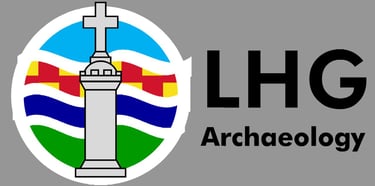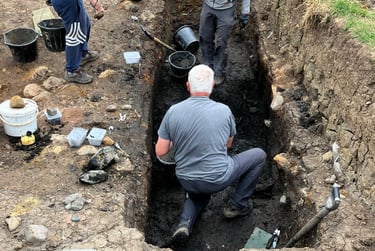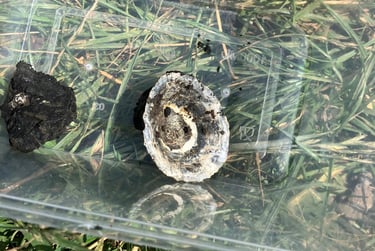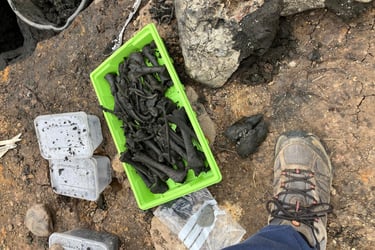Hunting Hall Archaeology Blog
A daily account of our Hunting Hall dig.


27th June 2025 : Dig Diary Day 26
My thanks to Kristian for today’s dig diary.
We made a lot of progress today, and the weather was kind to us. We are resolving the features in Trench 10 quite confidently, exposing trenches in which the cobbling was placed. A suspicion that we might have the vestiges of another roundhouse disturbed by later ditches is emerging, which can be tested through the radiocarbon dates from bones recovered in these. This provides a nice sequence of occupation, and will in turn decisively demonstrate that the palisade and the ring ditch were cut into this older roundhouse. It is likely Iron Age, but how much older than it is vis-à-vis the ditches remains to be determined through radiocarbon samples. The excavations of these was done very nicely by Lorna, Dominic, Sue, Poppy, and her father.
John HR was digging deeply in the palisade ditch, and recovered a cattle femur to add to our collection of teeth and the mandible. Again, these are welcome finds to establish an absolute date for the palisade. We began the excavation here assuming that this was a pit, but as we got deeper into this feature, it has become apparent that we are on the southern margin of the palisade. This was accompanied by some charcoal, however, sadly there is no ceramic or any other cultural material within this fill. Carole diligently sought out some dating material from a pit that we dug quite some time ago that contained the haematite that derives from Cumbria. It seems that she was successful !
A copious quantity of faunal material is coming out of Trench 8 which is much more complex than we had anticipated. Despite reaching a depth of 2.55 metres. we have not found the base. Why is this so different from the excavations last year ? We have limpet shells, and now a large quantity of bird bone and bone from smaller mammals. All are embedded in a thick and undifferentiated organic layer replete with decaying wood and presumably ash. We entertained ideas that we might have struck an older glacial deposit such as a kettle hole, or perhaps a fossil rivulet, but this does not agree with the limpet shells which could not be introduced by anything other than anthropogenic agency -- or the more remote possibility that some prehistoric sea gull dropped them ! In short, we are probably not able to reach the bottom, albeit we shall try to core into this using an auger than John HR has or alternately submerge a DIY core into this to strike the basal layers. We will spend the next few days recording what we can here, but it has become quite the puzzle. It is an extraordinary sequence which we must elucidate through sedimentary samples and so on.
(Kristian added a postscript: ‘I am genuinely perplexed!’.
How does he think the rest of us mere mortals feel?)






